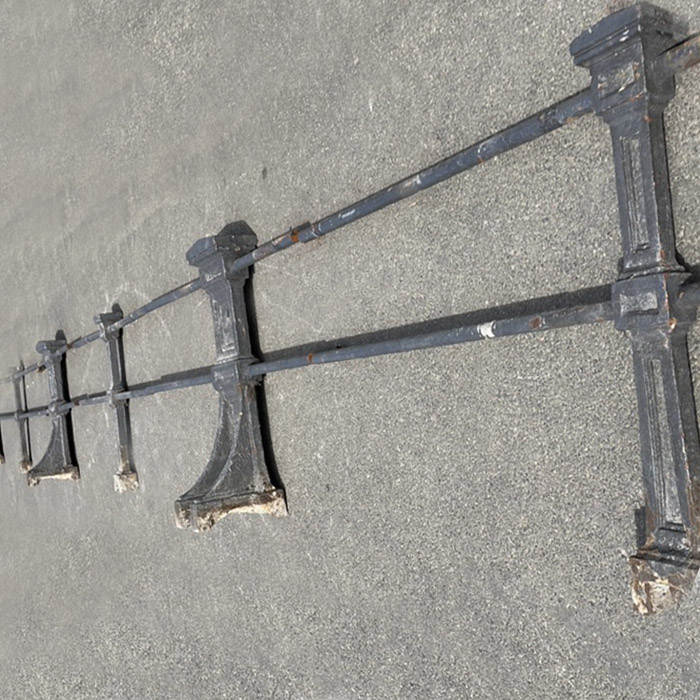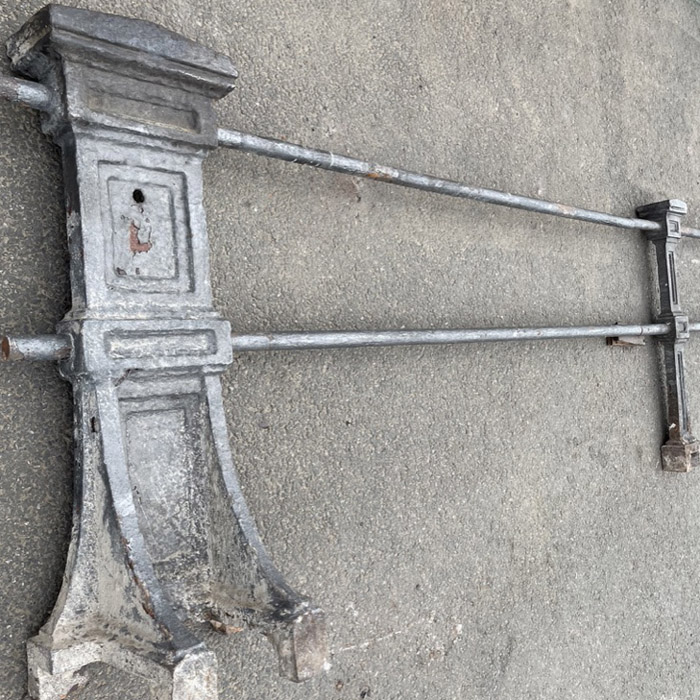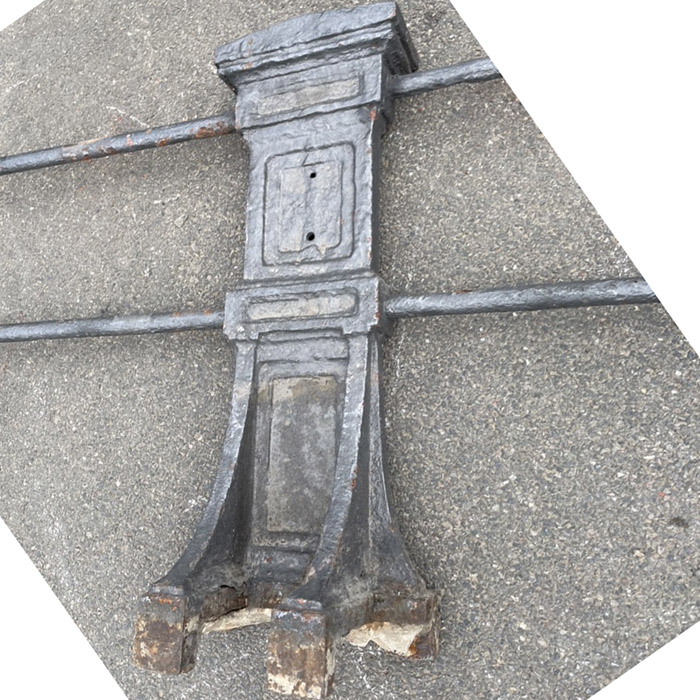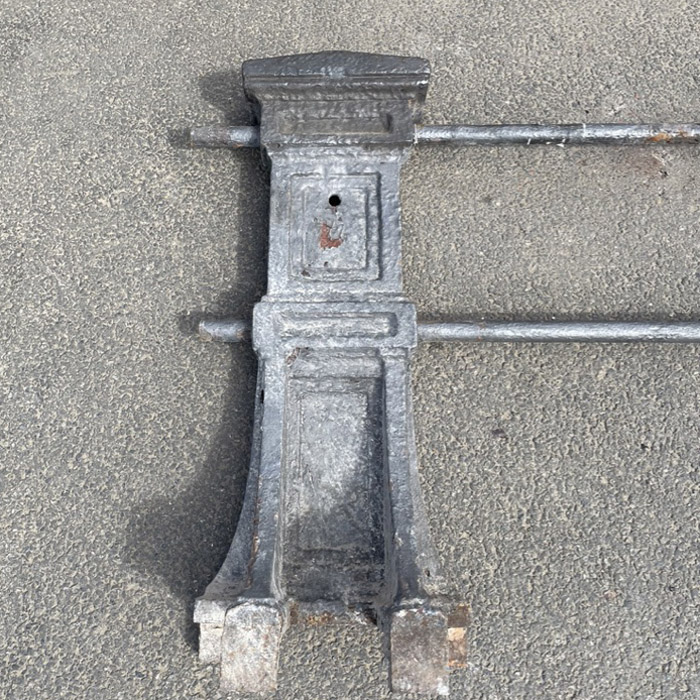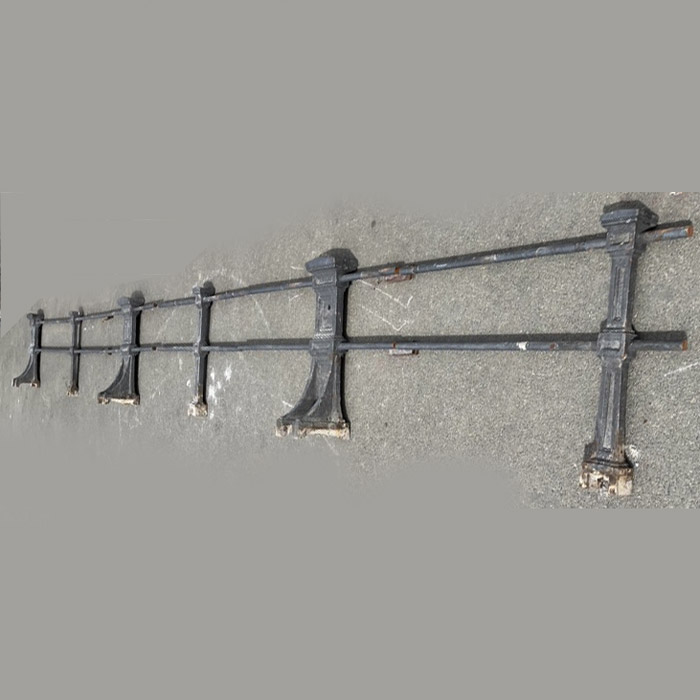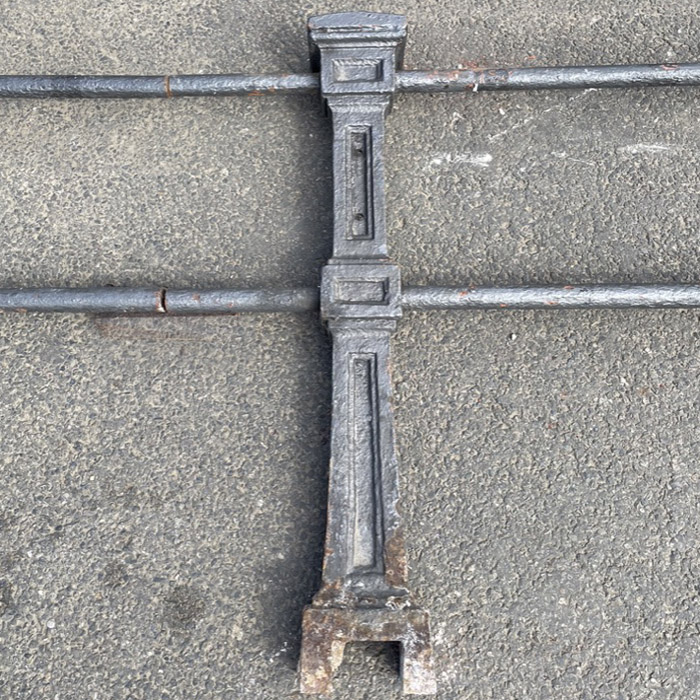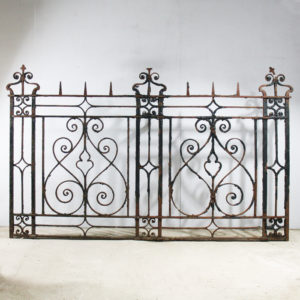Click and Collect – Please contact us to arrange collection or delivery of this item
A unique run of very early English cast-iron railway parapet railing
comprising six stanchions, three each of large and small - alternating, decorated with recessed panels and linked with two cast iron rails running through them; very heavily sand-cast, old paint, the rails cut for removal,
£5,000 the lot
These East London railings were removed from the parapet of a brick viaduct near Three Colt Street Bridge at the former Limehouse Station. They were salvaged in 1985 by The Ragged School Museum – the Museum of The East End. The Museum was keen to save the railing (the Docklands Light Railway (DLR) was being built along the route), as by then it was the last surviving section of the original early Victorian railing. The railing originally lined both sides of the viaduct for much of its 3 1/4 miles run from the Minories (the original terminus) eastwards to the other end at Brunswick Wharf, Blackwall.
The surviving run comprises six stanchions – alternating thick and thin. These upright posts are decorated with recessed moulded panels. They are linked by two cast iron rails running through them. They are surprisingly heavy: each component was sand-cast in iron. The sheer weight of them must have contributed to their demise – a high scrap value – but the original viaduct with miles of this railing must have looked very smart on completion of the London and Blackwall Railway in 1840.
As the last survivors, these railings are notable. They are early – over 180years old. They were almost certainly designed either by architect Sir William Tite (1798-1873) or by George Parker Bidder (1806-1878) – a child prodigy, mathematical genius and Civil Engineer who had met Robert Stephenson (1803-59) at university in Edinburgh and who later took on responsibility for the engineering and design of the London and Blackwall infrastructure alongside him. The “Mechanic and Chemist” journal of 18th July 1840 commented that the “light and ornamental iron palisade” was by comparison an aesthetic and acoustic improvement on the solid parapet of the London and Greenwich Railway. Later, The Survey of London notes that the “railings were soon replaced with parapet walls, in some places as early as 1849, during alterations for the conversion to locomotive power”. From the outset the risk of fire from locomotives on raised viaducts through densely populated districts was an over-riding design consideration and explains the initial avoidance of locomotive traction on this very early railway.
The London & Blackwall Railway – A Brief History
The Act of Parliament in July 1836, that commissioned the building of the railway, was titled “An Act for making a Railway from the Minories to Blackwell, with Branches, to be called “The Commercial Railway””. It was to be a passenger line for the various wharves along the north bank servicing the Thames down-river and cross-channel paddle-steamers. It was the first urban rapid transit railway in the world, the second elevated railway, and the first to be controlled by electric telegraphy. It should be noted that the commissioning of The Commercial Railway was only six years after the triumphant opening of the Liverpool & Manchester Railway with the Stephensons’ celebrated “Rocket”. All of the lessons of superimposing the then burgeoning railway lines into City Centre terminii – the elevated tracks, the compulsory purchases and legal wrangling were learned here in East London first – The London and Blackwall was the first to breach the City walls when it reached Fenchurch Street.
Robert Stephenson (with much involvement from his father George) was ultimately engaged for the project – inheriting it from his competitor Sir John Rennie whose chosen route and gauge of track were to remain problematic. William Tite designed the terminus stations and the architectural fixtures and fittings – Tite was constructing the new Royal Exchange at the time but railway architecture was his thing. Thomas Cubitt (1788-1855) was involved, I.K.Brunel declined.
Remarkably, Stephenson opted for the railway to be powered by rope rather than locomotive. He built winding stations at each end of the line – using gradient to accelerate and brake the passenger cars as they arrived and left. Fourteen miles of rope was required for the pair of bi-directional tracks; the rope was made locally in Limehouse at Joseph Huddart’s Patent Cable Manufactory.
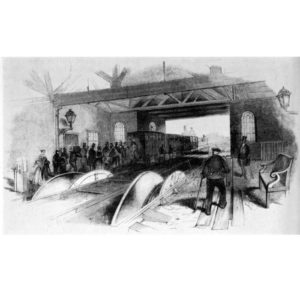
Within a year the extension continued eastwards into the City at Fenchurch St. and the line was rechristened “The London and Blackwall Railway”; East Enders nicknamed it “The Fourpenny Rope”. The time-table was simple – a train every fifteen minutes – but passengers both in first (seated) and second class (standing) had to be mindful of the carriage they boarded: the train would shed or “slip” its rear-most carriage at the intermediate stations until only the front two carriages would reach the final stop (it would collect them, rebuilding the train, on the way back). In was an ingenious system that, together with the telegraph signalling, was invented by Bidder. However, the rope system never worked well – there were continual snappages – it was replaced with steel cable after a few years which proved too heavy and prone to ferocious twists and kinks.
Inevitably, re-gauging the track ensued, and locomotives replaced the stationary steam engines in 1849. As above, much of the parapet railing was removed at this point due to widening of the viaduct and to contain sparks from the incoming locomotives.
By the 1860’s London had seen a flourishing of railways – Tite had been busy building elegant railway Terminii including the rather grand Nine Elms Station for the London and Southampton Railway (a stone’s throw form LASSCO Brunswick House) – and the L&B was by then considered rather small and old-hat. Charles Dickens dubbed it the V.D.S.C.R.C (Very Dirty and Small Coal Railway Company).
The London & Blackwall gained junctions and extensions, shareholders started to do much better, the operating company was merged and bought out a few times (it ended up as part of the LNER network) and more freight was included in its workload. However it suffered competition from Trams as the years went by and its services were being pulled and truncated from the 1920’s, station closures followed during the Second War. There was further decline through the 1950’s and finally abandonment of the line in 1963. The 1840 brick viaduct, with 285 semi-elliptical arches, is now listed and but any of the original iron railings are long gone – some replaced more recently with fibre-glass railing.
John Betjamen remembered the London & Blackwall from his youth writing in “First and Last Loves” (1952):
“Those frequent and quite empty trains of the Blackwall Railway ran from a special platform at Fenchurch Street. I remember them. Like stagecoaches they rumbled past East End chimney pots, wharves and shipping, stopping at empty black stations till they came to a final halt at Blackwall station…When one emerged there, there was nothing to see beyond it but a cobbled quay and a vast stretch of wind whipped water….”
He would have trundled past the only surviving parapet railings at Limehouse – now with us at LASSCO.
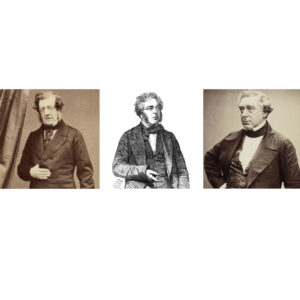
Above:The Key players in the London & Blackwall Railway
Left: Architect Sir William Tite (1798-1873) – twice President of the RIBA, best known for The Royal Exchange in the City of London and made a lucrative profession in designing Railway terminii for the burgeoning Railway companies – the L&B included. Tite Street in Chelsea is named after him.
Centre: “The Boy Calculator” George Parker Bidder (1806 – 78) was in his youth paraded by his father around fairs as a freak-show attraction such was his ability for mental arithmetic. He fell-in with Stephenson at Edinburgh and they worked together on numerous railway projects. An extraordinary civil engineer and inventor Bidder’s ability to spot problems, solutions and opportunities at the drawing board brought him into most of the big infrastructure projects of the day as a consultant. The rope system at The L&B was his, as was the electric telegraph. Either Bidder or Tite designed the parapet railings.
Right: Robert Stephenson (1803-59) Perhaps the greatest engineer of the 19th Century, Robert took on his father’s extraordinary legacy – they worked closely together. His was the groundbreaking “Rocket” steam engine. By 1850 he was responsible for overseeing a third of the nation’s railways and some outstanding bridges. George “Father of the Railways” had Robert, his only son, privately educated with a “received pronunciation” in order he didn’t encounter the snobbery that his father had continually come up against with his Geordie accent.

